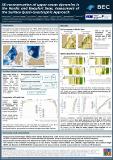Por favor, use este identificador para citar o enlazar a este item:
http://hdl.handle.net/10261/304022COMPARTIR / EXPORTAR:
 SHARE
BASE SHARE
BASE
|
|
| Visualizar otros formatos: MARC | Dublin Core | RDF | ORE | MODS | METS | DIDL | DATACITE | |

| Título: | 3D Reconstruction of Upper Ocean Dynamics in the Nordic and Beaufort Seas. Assessment of the Surface Quasi-Geostrophic Approach |
Autor: | Umbert, Marta CSIC ORCID ; Isern-Fontanet, Jordi CSIC ORCID ; Mateos García, Anna; Gutiérrez-García, Marina; Gabarró, Carolina CSIC ORCID ; Bertino, Laurent; Raj, Roshin P. | Palabras clave: | Arctic Ocean dynamics Ocean currents Surface quasi-geostrophy Physical oceanography |
Fecha de publicación: | jul-2022 | Citación: | VII Encuentro de Oceanografía Física - Expanding Ocean Frontiers Conference (2022) | Resumen: | We have assessed the capability of Surface Quasi-Geostrophy (eSQG) to reconstruct the three-dimensional (3D) dynamics in two key areas of the Arctic Ocean: the Nordic and the Beaufort Seas. We reconstructed the upper ocean dynamics from sea surface height (SSH), surface buoyancy (SSB) and surface velocities and validated the results with the classical geostrophic and original TOPAZ reanalysis velocities. When compared to geostrophic velocities, the results demonstrated that the reconstruction of upper ocean dynamics using SSH fields is in high agreement, with correlation coefficients greater than 0.8 for the upper 400 m. SSH reconstructions outperforms surface buoyancy reconstructions also in places near freshwater inputs from river discharges, melting sea ice and glaciers. Surface buoyancy fails due to the uncorrelation of SSB and subsurface potential vorticity (PV). Reconstruction from surface currents correlates to TOPAZ velocities with correlation coefficients greater than 0.5 up to 200 meters. Due to a deeper thermocline and halocline, the performance of the eSQG approach is better in the fall and winter than in the spring and summer. Our results demonstrate that using only surface information from SSH or surface velocities, it is possible to effectively reconstruct upper ocean dynamics in the Arctic and Subarctic Seas up to 400 meters. Future remote sensing missions in the Arctic Ocean, like Seastar, WaCM, CIMR, and CRISTAL, will give improved and enhanced SSH and surface velocities observations, allowing SQG schemes to characterize upper ocean 3D dynamics | Descripción: | VII Encuentro de Oceanografía Física (EOF) - Expanding Ocean Frontiers Conference, VIII International Symposium on Marine Sciences, 6-8 July 2022, Las Palmas de Gran Canaria, España | Versión del editor: | This work has been carried out thanks to European Union’s Horizon 2020 research and innovation programme under the Marie Skłodowska-Curie Grant Agreement No. 840374. We also received funding from the Spanish government through the “Severo Ochoa Centre of Excellence” accreditation (CEX2019-000928-S) | URI: | http://hdl.handle.net/10261/304022 |
| Aparece en las colecciones: | (ICM) Comunicaciones congresos |
Ficheros en este ítem:
| Fichero | Descripción | Tamaño | Formato | |
|---|---|---|---|---|
| Umbert_et_al_2022.pdf | 1,49 MB | Adobe PDF |  Visualizar/Abrir |
CORE Recommender
NOTA: Los ítems de Digital.CSIC están protegidos por copyright, con todos los derechos reservados, a menos que se indique lo contrario.
